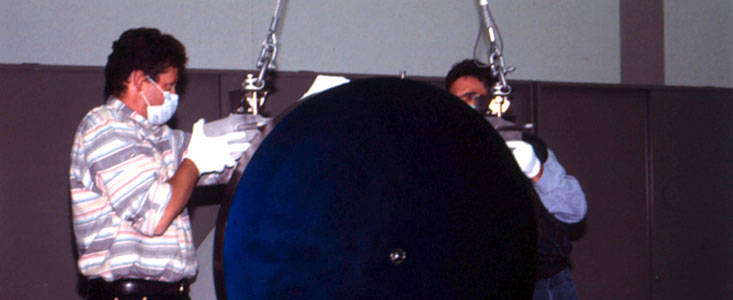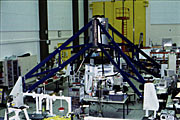Persbericht
First M2-Unit and Beryllium Mirror Delivered to ESO
12 december 1997
Just as the first 8.2-metre Zerodur VLT primary mirror (M1) is arriving at the Paranal Observatory, there are also good news about the first of the 1.2-m Beryllium VLT secondary mirrors (M2) and its Supporting Unit . This assembly is placed at the top of the VLT 'telescope tube'.
The positioning of the M2 mirror is computer-controlled and it forms part of the VLT Active Optics System that maintains the optical quality of the VLT. During observations in the infrared spectral region, it is used in a `chopping mode' which allows to shift rapidly between the celestial object being observed and a neighbouring sky field in order to improve the signal-to-noise ratio. For this reason, the secondary VLT mirrors and their mechanical support systems have to be very light. This is why it was decided to use for the first time ever the very light, exotic metal Beryllium for a large telescope mirror.
These critical parts of the Very Large Telescope have now successfully passed the final and most crucial phase of their acceptance tests in the integration hall of Dornier Satellitensysteme (Friedrichshafen, Germany). This concludes a period of more than seven months of severe tests performed to guarantee that the Secondary Unit and its mirror meet the stringent requirements necessary to ensure the full optical quality of the VLT. This period has been characterized by a close interaction between the Dornier and the ESO team following the project to establish the complex test procedures and to review the results.
This programme started in May 1997 with the testing of the computer software, closely followed by the testing of the electro-mechanical unit, done with the help of a light-weighted dummy mirror. The test results, although successful, lead to a number of improvements and further optimization, performed by Dornier during the following months.
During the same period, REOSC Optique in Paris - the firm that is responsible for the polishing of the giant 8.2-m primary mirrors (M1) - completed the final polishing of the first Beryllium mirror. After integration with its titanium support system, and following extensive optical testing, it was delivered to Dornier in September 1997.
There, the mirror was dynamically tested to determine its inertia and the accurate position of its center of gravity, both crucial elements for the proper balancing of the chopping mechanism. In October, the M2 mirror was then inserted for the first time into the M2 Support Unit to check the differences between the dummy and the real mirror. Finally, a test setup with the real telescope spiders that carry the M2 and its support was prepared and assembled in the integration hall at Dornier in November. Due to the flexible mounting, it was possible to detect any, even very tiny imbalance in the M2 Unit that might possibly affect the telescope pointing.
These final tests were successful and have now lead to provisional acceptance by ESO of the M2 Unit. They have shown full compliance with the ESO chopping and tip-tilt (field stabilization) requirements and have also demonstrated the feasibility to tune the system for active rejection of unwanted mechanical resonances.
The ESO engineers are thus optimistic about the upcoming integration of the first M2 Unit into the first VLT Unit Telescope (UT1). The M2 Unit is now being packed and will soon be shipped to the Paranal Observatory in its special container.
More information is available at the ESO website about the VLT project.
Over dit bericht
| Persberichten nr.: | eso9732 |
| Legacy ID: | Photo 34a-b/97 |
| Naam: | Mirror, Very Large Telescope |
| Type: | Unspecified : Technology : Observatory : Telescope |
| Facility: | Very Large Telescope |
Our use of Cookies
We use cookies that are essential for accessing our websites and using our services. We also use cookies to analyse, measure and improve our websites’ performance, to enable content sharing via social media and to display media content hosted on third-party platforms.
ESO Cookies Policy
The European Organisation for Astronomical Research in the Southern Hemisphere (ESO) is the pre-eminent intergovernmental science and technology organisation in astronomy. It carries out an ambitious programme focused on the design, construction and operation of powerful ground-based observing facilities for astronomy.
This Cookies Policy is intended to provide clarity by outlining the cookies used on the ESO public websites, their functions, the options you have for controlling them, and the ways you can contact us for additional details.
What are cookies?
Cookies are small pieces of data stored on your device by websites you visit. They serve various purposes, such as remembering login credentials and preferences and enhance your browsing experience.
Categories of cookies we use
Essential cookies (always active): These cookies are strictly necessary for the proper functioning of our website. Without these cookies, the website cannot operate correctly, and certain services, such as logging in or accessing secure areas, may not be available; because they are essential for the website’s operation, they cannot be disabled.
Functional Cookies: These cookies enhance your browsing experience by enabling additional features and personalization, such as remembering your preferences and settings. While not strictly necessary for the website to function, they improve usability and convenience; these cookies are only placed if you provide your consent.
Analytics cookies: These cookies collect information about how visitors interact with our website, such as which pages are visited most often and how users navigate the site. This data helps us improve website performance, optimize content, and enhance the user experience; these cookies are only placed if you provide your consent. We use the following analytics cookies.
Matomo Cookies:
This website uses Matomo (formerly Piwik), an open source software which enables the statistical analysis of website visits. Matomo uses cookies (text files) which are saved on your computer and which allow us to analyze how you use our website. The website user information generated by the cookies will only be saved on the servers of our IT Department. We use this information to analyze www.eso.org visits and to prepare reports on website activities. These data will not be disclosed to third parties.
On behalf of ESO, Matomo will use this information for the purpose of evaluating your use of the website, compiling reports on website activity and providing other services relating to website activity and internet usage.
Matomo cookies settings:
Additional Third-party cookies on ESO websites: some of our pages display content from external providers, e.g. YouTube.
Such third-party services are outside of ESO control and may, at any time, change their terms of service, use of cookies, etc.
YouTube: Some videos on the ESO website are embedded from ESO’s official YouTube channel. We have enabled YouTube’s privacy-enhanced mode, meaning that no cookies are set unless the user actively clicks on the video to play it. Additionally, in this mode, YouTube does not store any personally identifiable cookie data for embedded video playbacks. For more details, please refer to YouTube’s embedding videos information page.
Cookies can also be classified based on the following elements.
Regarding the domain, there are:
- First-party cookies, set by the website you are currently visiting. They are stored by the same domain that you are browsing and are used to enhance your experience on that site;
- Third-party cookies, set by a domain other than the one you are currently visiting.
As for their duration, cookies can be:
- Browser-session cookies, which are deleted when the user closes the browser;
- Stored cookies, which stay on the user's device for a predetermined period of time.
How to manage cookies
Cookie settings: You can modify your cookie choices for the ESO webpages at any time by clicking on the link Cookie settings at the bottom of any page.
In your browser: If you wish to delete cookies or instruct your browser to delete or block cookies by default, please visit the help pages of your browser:
Please be aware that if you delete or decline cookies, certain functionalities of our website may be not be available and your browsing experience may be affected.
You can set most browsers to prevent any cookies being placed on your device, but you may then have to manually adjust some preferences every time you visit a site/page. And some services and functionalities may not work properly at all (e.g. profile logging-in, shop check out).
Updates to the ESO Cookies Policy
The ESO Cookies Policy may be subject to future updates, which will be made available on this page.
Additional information
For any queries related to cookies, please contact: pdprATesoDOTorg.
As ESO public webpages are managed by our Department of Communication, your questions will be dealt with the support of the said Department.


